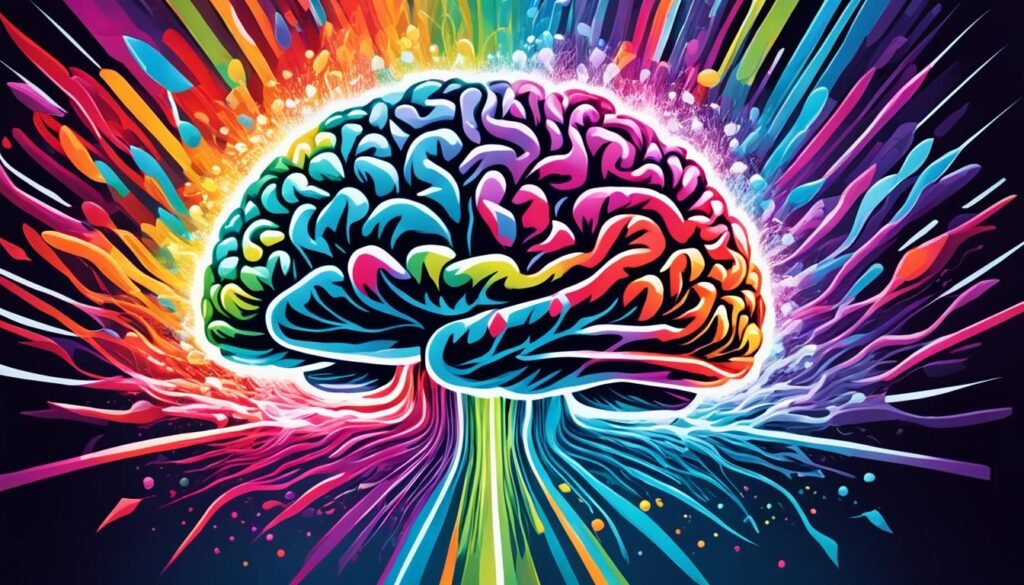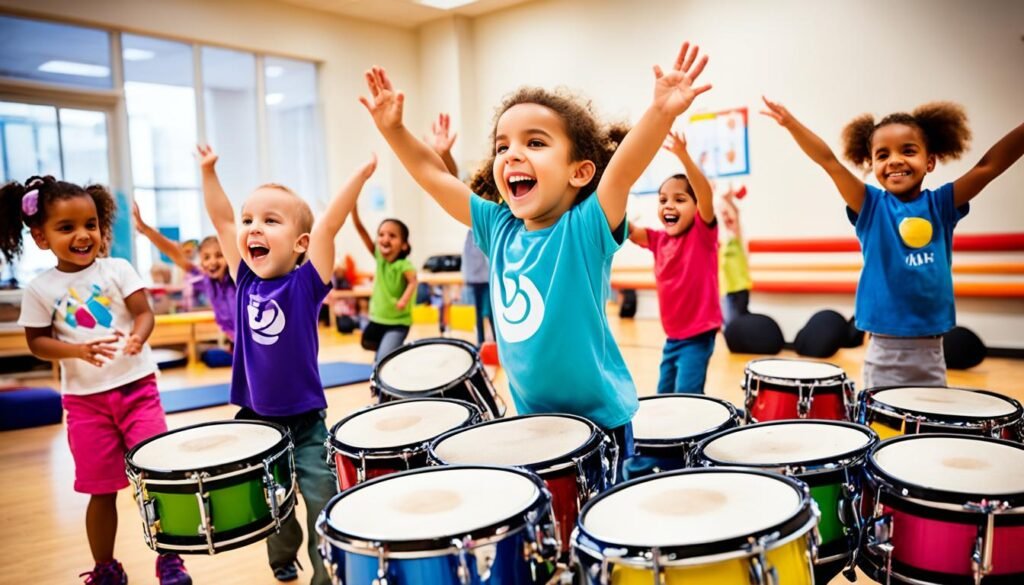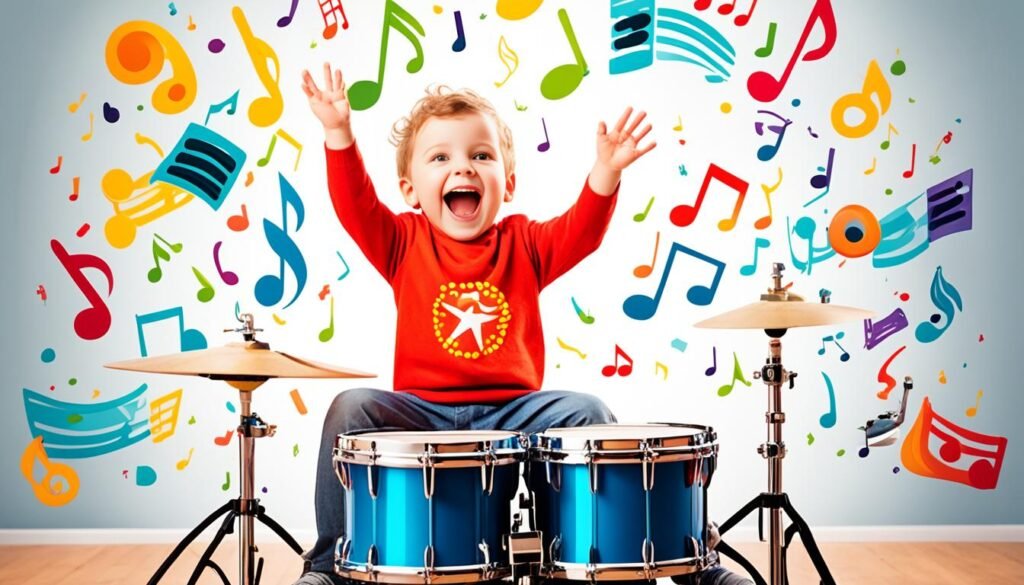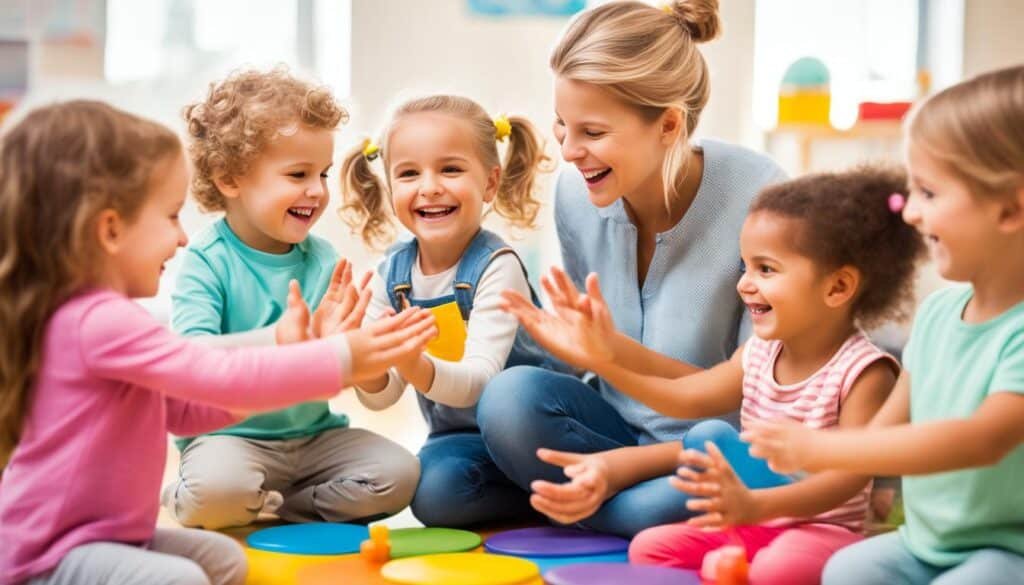Rhythm For Young Minds do more than just entertain. They actually make our brains work better. When we listen to music, many parts of our brain get involved, not just the right side. This includes areas for movement, feelings, and creativity.
Music makes our brain networks work together better. It helps our brain’s hemispheres talk to each other. This makes learning easier and boosts our thinking skills.
Rhythm is powerful for healing and making our brains flexible. It helps us make sense of the world by creating patterns. It also changes how we see and think about things.
Learning new things gets better when tied to a rhythm. Our memory improves when we connect new info with a beat.
Key Takeaways
- Music and rhythm activate the whole brain, not just the right hemisphere.
- Rhythm helps organize events into predictable patterns, influencing perception and thinking.
- Learning and memory are stimulated when linked to specific beats in a rhythm.
- Music activates large-scale neural networks, implying a close connection between music and movement.
- Music uses most of the brain in wide circuits, enhancing neuronal communication and cognitive abilities.
Introduction to the Importance of Rhythm
Rhythm is a key part of music that helps young minds grow. It shows how music, rhythm, and the brain work together. Research shows rhythm’s big effect on thinking and moving skills.
The Connection Between Music, Rhythm, and Brain Development
Music makes the brain work hard, touching areas for movement, feelings, and creativity. This link between music, rhythm, and movement shows they’re key for learning. Rhythm is special for healing and changing the brain, making things predictable and affecting how we think and see things.
How Rhythm Impacts Various Cognitive and Motor Skills
Studies show that rhythm helps with learning and remembering things. It’s key for thinking skills. Music’s rhythm also gives kids a sense of safety and order, helping them feel secure.
By playing with rhythm, kids get better at moving, thinking ahead, and predicting time. This sets them up for success in school and sports.
Rhythm’s effect on the young brain is clear. It’s a powerful tool for teachers and parents. Adding rhythmic activities to learning and fun helps kids grow and reach their full potential.
Also Read: These 50 Photos Of Unique People Show That Genetics Is Hard To Forget
Whole-Brain Activation Through Music and Rhythm

Rhythm is a powerful tool that engages the brain in many ways. Music and rhythm activate wide networks in the brain. These include areas for motor actions, emotion, and creativity.
Music uses most of the brain in wide circuits. This helps with better learning and boosts cognitive abilities. It also improves communication between the brain’s hemispheres.
Research Findings on Brain Areas Stimulated by Music and Rhythm
Studies show that the brain processes music’s features like rhythm, tonality, and timbre. This stimulates emotional, motor, and creative areas. The rhythmic nature of music stimulates and coordinates various brain regions.
This leads to a heightened sense of security and well-being during musical experiences.
The Role of Movement in Wiring the Brain for Rhythm Perception
Research highlights the role of movement in wiring the brain for rhythm perception. Hearing the beat alone isn’t enough for forming long-term neural pathways. Movement, combined with rhythm, triggers a unique effect on the brain.
Also Read: Exploring The Premier Music Colleges For Career Advancement
This improves learning in various ways. It allows children to move along to the regular beat and find the beat more effectively. This enhances their sense of rhythm and musical understanding.
“Music uses most of the brain in wide circuits, enabling better learning and boosting cognitive abilities through enhanced neuronal communication between the brain’s hemispheres.”
Enhancing Language and Communication Skills

Rhythm is key in how we process language and communicate. It helps us pick out sounds, words, and phrases in speech. Having good rhythm skills is vital for music, dance, and language growth.
Research shows rhythm isn’t just something you’re born with. It can be learned and improved. This training boosts language skills and communication. It also helps kids get better at predicting the rhythm in speech.
The rhythmic pattern in language helps kids develop their sense of rhythm and coordination. This boosts their language and communication skills. It also helps their brain grow and gives them a sense of security.
Also Read: How Music University Enhances Academic And Creative Growth
The Link Between Rhythm and Language Processing
Studies show that keeping a steady beat is linked to better language skills in kids. Kids who are good at rhythm find it easier to follow a song’s beat. They move better and keep the rhythm even when the music stops.
This connection between rhythm and language skills is strong. Rhythmic activities help kids improve their memory, language, and social skills. They make learning fun and engaging.
“Rhythm is the foundation of language. It is the rhythmic nature of language that allows us to segment the speech stream into words, phrases, and sentences.”
Improving Reading, Writing, and Mathematical Skills

Rhythmic training boosts literacy and numeracy skills. It strengthens language processing, reading, and math skills. This is because rhythm and language are closely linked.
Activities that mix movement and music help learning and memory. They also improve skills needed for reading, writing, and math.
Also Read: Why Every School Needs A Vibrant Music Education Program
Rhythmic Training Enhances Literacy
Rhythmic training helps kids with learning issues like dyslexia read and write better. It uses clapping, tapping, or moving to a beat. This activates brain areas for language and literacy.
Rhythmic Training Supports Numeracy
Music’s rhythm aids math skills too. Keeping a steady beat helps with math concepts and operations. Activities like marching or clapping to nursery rhymes improve math skills.
| Literacy Skills | Mathematical Skills |
|---|---|
|
|
Using rhythmic exercises in music and learning helps kids. It builds a strong sense of rhythm. This boosts their literacy and numeracy skills.
Also Read: Unlocking The Secrets Of Top Jazz Music Universities
Rhythm For Young Minds
Learning about rhythm is key for young kids. It helps with thinking, moving, and feeling emotions. Kids learn a lot by hearing the beat, moving to it, and doing rhythmic activities.
Doing things like marching, clapping, and dancing makes the brain better at understanding rhythm. This is good for learning words, numbers, and how to get along with others. Adding rhythm and music to daily life makes kids happier and more secure.
Activities like rhythmic exercises and musical activities help kids get better at rhythm. This is great for their thinking and moving skills. Kids can have fun learning by clapping to songs or marching to a drum track.
“Music education plays a significant role in a student’s academic performance, emotional well-being, and overall development by enhancing learning skills, boosting cognitive abilities, and fostering social connections.”
Kids can improve their language, coordination, and social skills by tapping their feet or clapping to music. Adding rhythm-based activities to school and home helps kids reach their full potential.
Rhythm and Motor Coordination
Music and movement make kids move together with the steady beat. This helps with their motor coordination and physical skills. Marching or clapping to music helps the brain and improves memory and coordination.
| Rhythmic Activity | Developmental Benefits |
|---|---|
| Tapping to a Steady Beat | Improved Motor Coordination, Sense of Rhythm |
| Clapping Along to Nursery Rhymes | Enhanced Memory, Language Processing, Social Skills |
| Marching to the Beat of a Drum | Increased Coordination, Physical Activity, Spatial Awareness |
| Dancing to Favorite Tunes | Emotional Expression, Social Interaction, Creativity |
These rhythmic activities help kids get better at rhythm and motor coordination. This prepares them for success in sports, dance, and other physical activities.
Boosting Coordination and Motor Skills

Rhythmic skills are key to motor coordination. They help kids do better in sports and games. Many kids who find sports hard often struggle with keeping a beat. This shows how important it is to work on rhythm to improve coordination.
The Connection Between Rhythmic Abilities and Motor Coordination
Studies link rhythmic skills with motor abilities. Kids who can keep a good beat do well in sports and dance. Rhythmic exercises help grow the brain areas that control timing. This makes kids better at sports and other physical tasks.
The Impact of Rhythmic Training on Sports and Physical Activities
Music and movement exercises boost sports and physical skills. They work the brain’s motor areas and improve timing skills. These are key for moving with a musical track or piece of music.
Adding rhythmic training to sports and PE can make kids more coordinated and confident. It helps them move better with music. This sets them up for a life of enjoying physical activities that are good for both body and mind.
Fostering Social-Emotional Development

Learning to keep a rhythm is great for the brain and body. It also helps kids grow socially and emotionally. Studies show that moving to a beat can boost self-confidence and social skills.
The Role of Rhythm in Building Self-Esteem and Social Skills
Kids who join in on games with rhythm are more likely to make friends. This helps them get better at working with others. Activities that make you move and work together can make kids feel happy and secure.
“Rhythm allows children to move and interact with others in a joyful, social-emotional way, which can help build self-esteem and foster strong social skills.”
Through rhythmic exercises and music education, kids can get better at keeping a beat. They learn to clap along and move in sync. These activities make the brain work better and help kids move together smoothly.
Adding rhythmic exercises and music-based activities to daily life helps kids grow socially and emotionally. It boosts their self-esteem, confidence, and ability to work with others.
Also Read: What Are The Key Characteristics That Define Classical Music?
Therapeutic Applications of Rhythmic Training
Rhythmic training is a key tool for helping people with neurological and developmental issues. It helps those with autism, dyslexia, and Parkinson’s disease. By learning to keep a steady beat, people can see big improvements in their lives.
Rhythm and Autism Spectrum Disorder
Kids with autism find joy in activities like clapping and playing drums. These activities boost their social skills, how they communicate, and their coordination. Rhythm gives them a sense of order, making them feel less anxious and more connected to the world.
Rhythmic Interventions for Dyslexia
Kids with dyslexia often find it hard to keep up with the rhythm of speech. But, rhythmic training can change that. Tapping to a beat or marching to a metronome can make reading easier and faster.
Rhythm and Parkinson’s Disease
Parkinson’s disease makes moving hard for people. But, rhythmic exercises can help. Moving to a steady beat can make walking, balancing, and moving better. Simple drums or a metronome can be powerful tools in fighting Parkinson’s symptoms.
FAQs
Q: What is the importance of teaching rhythm to young children?
A: Teaching rhythm to young children helps in the development of language processing, temporal prediction skills, and interpersonal skills.
Q: How does learning rhythm benefit the musical development of young minds?
A: Learning rhythm helps young children in understanding note values, notation, and different types of beats like quarter notes and half notes.
Q: What are some fun ways to teach rhythm to children?
A: You can consider using percussion instruments like shakers and drums, playing rhythmic games like the “name game,” or creating a drum track or piece for children to follow.
Q: How can rhythm exercises help children in learning to keep a steady tempo?
A: Rhythm exercises such as finding the beat, stomping to the rhythm, or following dance steps help children practice keeping a steady tempo while moving to music.
Q: What role does rhythm play in dancing and movement for young children?
A: Rhythm helps children to synchronize their movements with the beat of the music, improving their coordination and motor skills during dance routines or activities.
Q: How can parents or teachers support young children in learning about rhythm?
A: Parents and teachers can help children by introducing them to simple rhythm patterns, encouraging them to clap or tap along with music, and providing opportunities to explore different tempo changes in songs.
Q: Are there specific musical activities that can enhance a child’s understanding of rhythm?
A: Yes, activities like the Dalcroze method, where children move in response to music and are asked to find the beat without music, can be beneficial in developing a sense of rhythm and timing.




